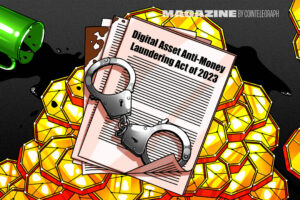
Bitcoin (BTC) faces a “trigger” moment that keeps a $1-million BTC price tag in play, one of its household names says.
In a blog post titled “The Periphery” released on Oct. 24, Arthur Hayes, former CEO of crypto exchange BitMEX, said that Bitcoin is already warning markets about the future.
“Global wartime inflation” to drive Bitcoin and gold price
With the United States increasingly invested in two new wars, the risk of escalation worldwide is growing, Hayes believes.
The timing is conspicuous — the United States Federal Reserve faces persisting inflation but has halted interest rate hikes, while a so-called “bear steepener” looms for the economy.
“The structural hedging needs of banks and the borrowing needs of the US war machine reflexively feed on one another in the US Treasury market,” he wrote.
“If long-term US Treasury bonds offer no safety for investors, then their money will seek out alternatives. Gold, and most importantly, Bitcoin, will begin rising on true fears of global wartime inflation.”
The writing is already on the wall. BTC/USD is up 15% this week, and the gains followed U.S. President Joe Biden’s address to the nation on the Ukraine and Israel wars.
Now, the blog post reiterates, “Directly after the Biden speech, Bitcoin — along with gold — is rallying against a backdrop of an aggressive selloff in long-end US Treasuries.”
“This isn’t speculation as to an ETF being approved — this is Bitcoin discounting a future, very inflationary global world war situation,” it continues.
Hayes is well known for his predictions of how global economics will play out post-COVID-19 and subsequent inflationary eras.
As part of the knock-on effects for Bitcoin, a $1-million BTC price tag is in play — something repeated on social media this week. This will come as a result of so-called yield curve control (YCC), the ultimate move in controlled economics already beginning to rear its head in Japan.
The bond vigilantes are yelling “down with the dollar.”
Look out for my spicy essay “The Periphery” dropping this week where I discuss the Hamas vs. Israel war, the US Treasury market, and $BTC.
YCC = $1mm $BTC is in full effect.
Yachtzee!!! pic.twitter.com/1ABcW1esaf
— Arthur Hayes (@CryptoHayes) October 23, 2023
“And the end game, when yields get too high, is for the Fed to end all pretence that the US Treasury market is a free market. Rather, it will become what it truly is: a Potemkin village where the Fed fixes the level of interest at politically expedient levels,” “The Periphery,” meanwhile, concludes.
“Once everyone realises the game we are playing, the Bitcoin and crypto bull market will be in full swing. This is the trigger, and it’s time to start rotating out of short-term US Treasury bills and into crypto.”
Dalio warns of “very costly” choices
As Cointelegraph reported, macro concerns are becoming ever more vocal this quarter thanks to the increasing presence of war.
Related: BTC price nears 2023 highs — 5 things to know in Bitcoin this week
Billionaire investor Ray Dalio, founder of the world’s largest hedge fund, Bridgewater Associates, recently put the odds of a “World War III” scenario developing at 50%.
BTC/USD monthly returns (screenshot). Source: CoinGlass
“I hope that the leaders of the great powers will wisely step back from the brink, even while they must prepare to be strong enough to successfully fight and win a hot war,” he wrote in a LinkedIn post on Oct. 12.
“In my opinion, for this to go well not only will the restraint of the participants be tested, but alliances that are prone to draw in non-fighting parties will also be tested. That is because being allied and helpful to the allied countries in these brutal wars is always very costly and raises the risks of being drawn fully into the war. That’s how local wars spread into world wars.”
Combined with buzz over an exchange-traded fund approval, Bitcoin is up 27% this October and over 100% year-to-date, per data from monitoring resource CoinGlass.
This article does not contain investment advice or recommendations. Every investment and trading move involves risk, and readers should conduct their own research when making a decision.
















